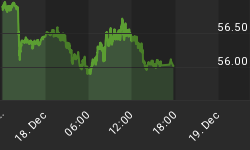What I found most interesting about the third quarter current account data was not that the U.S. deficit ran at a record annualized rate of $902.2 billion, nor that this represented 6.8% of nominal GDP, the second highest percentage since Q4:2005's 7.0%. No, what I found most interesting was, as shown in Chart 1, that for the fourth consecutive quarter, the U.S. ran a deficit in the income account. That is, for the fourth consecutive quarter, the income earned on foreign assets owned by U.S. entities was less than the income earned on U.S. assets owned by foreign entities. As Chart 1 shows, in the past 45 years it was a rare occurrence for the U.S. income account to be in deficit. Prior to the most recent four quarters, a deficit in the income account has occurred only four other times since 1960.
Chart 1
But a deficit in the income account probably is something we need to get used to. Why? When an entity - person, business or entire economy - runs a deficit, it means that it is borrowing from and/or selling assets to another entity. If a deficit is run persistently and at ever larger magnitudes, the lending entity starts to amass claims against the deficit entity in excess of its liabilities to the deficit entity. As Chart 2 shows, the U.S. has run a current account deficit in every year starting in 1982 except for a small surplus in 1992.
Chart 2
So, by running persistent current account deficits, the financial claims that the rest of the world has on the U.S. have been building up faster than the liabilities owed by the rest of the world to the U.S. As shown in Chart 3, this excess of foreign claims over liabilities reached $6 trillion in round numbers in the third quarter.
Chart 3
Even if the return on U.S. assets owned by foreign entities is less than the return on foreign assets owned by U.S. liabilities, the sheer magnitude of the net financial asset surplus position of the rest of the world at some point would turn the U.S. income account surplus into a negative. In other words, the rest of the world is "making it up on volume." What this deficit in the income account means is that the U.S. deficit in the goods/services account will have to narrow at a faster rate than otherwise if the overall current account deficit is to narrow. The arithmetic wind is now even more in our face if the current account deficit is to be narrowed.
By the way, it is not clear that Treasury Secretary Paulson's trip to China last week did much but to temporarily widen our current account deficit. After all, "tourism" is counted as an export to the country being visited. I would suggest that Secretary Paulson travel with a much smaller entourage in his next visit to China. Better yet, invite a large delegation of Chinese officials to the U.S. next time. At least this will work at the margin to narrow our current account deficit.















